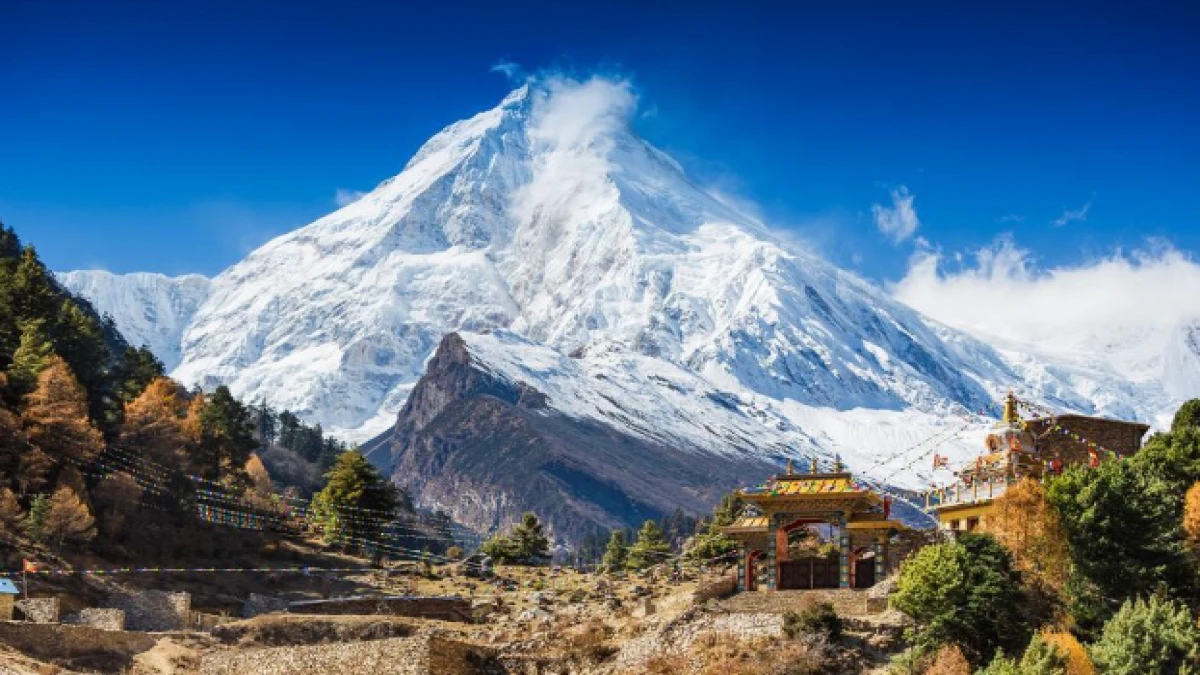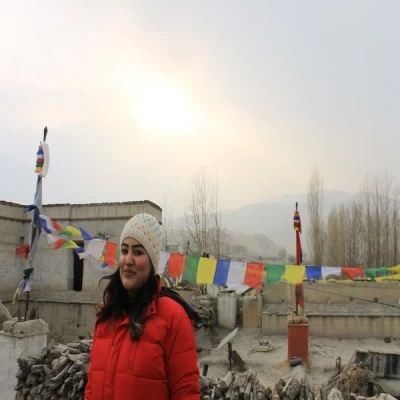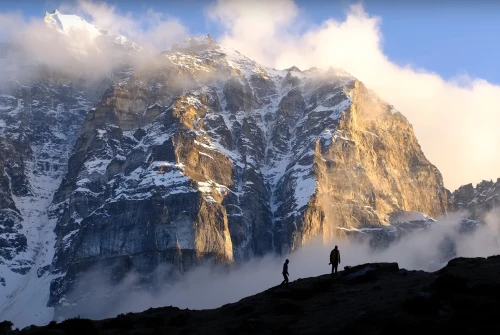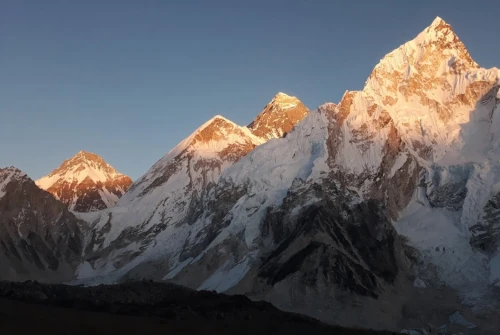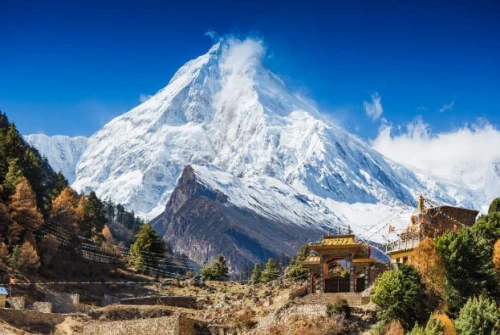Overview of the Manaslu Tsum Valley Trek
TheManaslu Tsum Valley Trek is one of the most remarkable long-distance treks in Nepal, combining the wild beauty of the Manaslu Circuit Trek with the spiritual depth of the Tsum Valley. Nestled in the remote Gorkha district near the Tibetan border, this trek takes us deep into a world of towering Himalayan peaks, lush forests, and centuries-old Buddhist culture that feels untouched by modern development. Unlike the busy trails of Everest and Annapurna, the Manaslu region remains a hidden treasure, offering trekkers both serenity and adventure.
As we walk through the Tsum Valley, often referred to as the “Hidden Valley of Happiness,” we are immersed in Tibetan Buddhist traditions, ancient monasteries, mani walls, and prayer flags that flutter against the backdrop of snow-clad peaks. The route then connects to the Manaslu Circuit, circling the eighth-highest mountain in the world, Mt. Manaslu (8,163m). Together, this journey offers a rare combination of cultural richness, spiritual experience, and breathtaking natural landscapes.
This trek is not just about high mountain passes and panoramic views; it’s also about stepping back in time. Villages here preserve traditions and lifestyles that have remained unchanged for centuries. As trekkers, we have the unique opportunity to witness authentic Tibetan-influenced communities, interact with warm-hearted locals, and gain insights into their spiritual way of life.
For those seeking an adventure that goes beyond the ordinary, the Manaslu Tsum Valley Trek promises an authentic Himalayan experience that balances challenge, culture, and serenity. Now, let’s dive into the most asked questions that trekkers want to know before embarking on this once-in-a-lifetime journey.
What Makes the Manaslu Tsum Valley Trek Unique?
The uniqueness of this trek lies in its ability to combine both natural wonders and cultural depth. While most treks focus either on mountain scenery or cultural exploration, the Manaslu Tsum Valley Trek offers both in abundance. The Tsum Valley was closed to outsiders until 2008, which helped preserve its authenticity. Trekking here feels like entering a hidden sanctuary where traditions thrive untouched.
Another highlight is the seamless transition between landscapes. The trek begins at lower altitudes, where we walk through rice terraces, dense forests, and fast-flowing rivers. As we ascend, the scenery transforms into alpine meadows, glacial valleys, and high mountain passes. The ultimate challenge is crossing the Larke La Pass (5,160m), one of the most spectacular high passes in Nepal, where views of Himalchuli, Himlung Himal, Cheo Himal, and Annapurna II leave us speechless.
But perhaps the most striking feature is the authentic Tibetan culture that flourishes in the region. We visit sacred monasteries like Mu Gompa and Rachen Gompa, encounter monks chanting prayers, and witness festivals that highlight deep Buddhist traditions. Unlike more commercialized trails, here we experience culture in its purest form, making this trek not just an adventure but also a spiritual journey.
Where Exactly is the Manaslu Tsum Valley Trek Located?
The trek is located in the northern Gorkha district of Nepal, bordering Tibet. It lies within the Manaslu Conservation Area, one of Nepal’s most biodiverse and culturally rich protected regions. The Tsum Valley itself is a side valley branching off from the main Manaslu Circuit, leading closer to the Tibetan border.
Getting there usually involves a scenic drive from Kathmandu to Soti Khola or Machha Khola, which takes about 7–8 hours. From there, we begin walking northward through the Budhi Gandaki Valley, following the river’s deep gorges and gradually ascending into higher, wilder landscapes. The Tsum Valley branches eastward from the village of Lokpa, guiding us into its mystical Buddhist realm.
Because of its remote location and restricted status, the trek feels untouched and pristine. We encounter fewer trekkers compared to popular trails, making it an ideal choice for those who want solitude and authenticity. Its location also ensures diverse scenery, from subtropical jungles to high alpine passes, all within a single trek.
When is the Best Time to Do the Manaslu Tsum Valley Trek?
Choosing the right season is crucial for a successful trekking experience. The best time to trek the Manaslu Tsum Valley is during spring (March to May) and autumn (September to November).
- Spring (March to May): This is when the forests along the trail bloom with rhododendrons and wildflowers. Temperatures are moderate, and mountain views are clear. It’s also an excellent time for photographers as the landscapes burst with vibrant colors.
- Autumn (September to November): The most popular season, autumn brings stable weather, clear skies, and crisp air. This is the perfect season for panoramic Himalayan views. Festivals like Dashain and Tihar also occur during this time, giving trekkers a glimpse of Nepali culture.
- Winter (December to February): Trekking is possible but challenging due to heavy snowfall at higher elevations. The Larke La Pass may be blocked, making the circuit incomplete. Only recommended for experienced trekkers with proper cold-weather gear.
- Monsoon (June to August): This is the least favorable season. Trails become slippery, leeches are common, and landslides may block paths. However, the valley looks lush and green, and fewer trekkers mean more solitude.
How Difficult is the Manaslu Tsum Valley Trek?
The Manaslu Tsum Valley Trek difficulty is often described as moderate to challenging, making it suitable for trekkers with good fitness levels and some prior trekking experience. Unlike the Annapurna or Everest trails, which have more infrastructure, this trek takes us into a remote and wild region where trails can be rugged and facilities more basic. The journey requires stamina, endurance, and determination.
On average, we walk 6 to 8 hours per day, covering steep ascents, rocky paths, and suspension bridges across roaring rivers. The most demanding part of the trek is crossing the Larke La Pass at 5,160 meters, where the thin air and long walking hours test our resilience. Proper acclimatization is crucial to prevent altitude sickness, which is a risk once we ascend above 3,000 meters.
That being said, the trek is not only about physical endurance but also about mental preparation. The remote setting means fewer comforts, colder nights at higher altitudes, and limited food choices as we go higher. With the right mindset, gradual pacing, and guidance from experienced trekking leaders, the challenges turn into an incredibly rewarding experience. The sense of achievement upon completing the trek, especially when standing at the top of Larke La Pass with panoramic views, is something truly unforgettable.
How Much Does the Manaslu Tsum Valley Trek Cost?
The cost of the Manaslu Tsum Valley Trek varies depending on trek duration, route, group size, and services included. On average, it ranges between USD 1,500 to USD 2,500 per person for a 20 to 24-day package. This typically includes permits, accommodations, meals, transportation, and guide/porter services.
Here’s a breakdown of major expenses:
- Permits: Around USD 100–150 per person, depending on the season, as restricted area permits are mandatory.
- Guide and Porter: A licensed guide costs about USD 30–40 per day, while a porter costs around USD 25–30 per day.
- Food and Accommodation: Teahouses charge USD 5–10 per night, and meals cost around USD 5–8 each. Prices rise as we climb higher due to transportation challenges.
- Transportation: The drive from Kathmandu to Soti Khola and return from Dharapani costs around USD 30–40 each way by local bus or more for private jeep hire.
Additional costs include personal expenses like snacks, hot showers, Wi-Fi, charging electronic devices, and tips for staff. While the trek is more expensive than standard treks due to restricted area permits and remoteness, the cultural richness and exclusivity make it worth every penny.
What Permits Do You Need for the Manaslu Tsum Valley Trek?
Because the Manaslu and Tsum Valley region is a restricted area, special permits are required. Independent trekking is not allowed—you must trek with a licensed guide through a registered trekking agency.
The required permits are:
Manaslu Restricted Area Permit (RAP):
- Needed between Jagat and Sama Gaon.
- Cost: USD 100 per person for the first 7 days (September to November) and USD 75 per person (December to August). Additional fees apply for extra days. Tsum Valley Restricted Area Permit:
- Required to enter the Tsum Valley.
- Cost: USD 40 per person per week (September to November) and USD 30 per person (December to August).
Manaslu Conservation Area Permit (MCAP): Cost: USD 30 per person.
Annapurna Conservation Area Permit (ACAP): Cost: USD 30 per person, as the trek exits into the Annapurna region near Dharapani.
Your trekking agency must arrange all permits before starting the trek. Carry multiple photocopies of your passport and visa for the application process.
What Accommodation and Food Can You Expect on the Manaslu Tsum Valley Trek?
One of the most common questions trekkers ask is about accommodation and food on the Manaslu Tsum Valley Trek. Since the region is remote and less commercialized compared to the Everest or Annapurna trails, facilities here are more basic but authentic.
Accommodation is provided in teahouses, small lodges run by local families. Rooms are simple, often consisting of two wooden beds with foam mattresses, blankets, and pillows. Bathrooms are usually shared, with squat toilets being common. In lower villages, some teahouses may provide attached bathrooms, but as we ascend higher, amenities become more limited. Heating is provided in the dining area with a bukhara stove (wood or yak dung fire), making it a cozy place for trekkers to gather in the evenings.
Food options vary depending on altitude. In the lower areas, we can enjoy a wider range of meals such as dal bhat (rice, lentils, vegetables), noodles, fried rice, momos (dumplings), Tibetan bread, soups, and eggs. As we climb higher, choices narrow down, and meals become more basic, often relying on locally available ingredients. The staple dal bhat is the most recommended meal, providing both energy and nutrition for long trekking days. Snacks, bottled water, and soft drinks are available but become more expensive the higher we go. Carrying energy bars, nuts, and rehydration salts is also advisable for extra stamina.
While luxury is limited, the simplicity of food and accommodation adds to the authenticity of the trek. Sharing meals with locals and experiencing their warm hospitality is an integral part of the Manaslu Tsum Valley experience.
What Should You Pack for the Manaslu Tsum Valley Trek?
Packing wisely is essential for this trek, as the weather and terrain change drastically from subtropical forests to high alpine passes. A well-prepared packing list ensures both comfort and safety.
Clothing Essentials:
- Base Layers: Moisture-wicking shirts and thermal tops for layering.
- Insulating Layers: Fleece jacket, down jacket, or wool sweater.
- Outer Layer: Waterproof and windproof jacket and pants.
- Trekking Pants and Shorts: Lightweight and quick-drying.
- Headwear & Gloves: Wool hat, sun hat, buff, warm gloves, and inner liners.
Footwear:
- Sturdy Trekking Boots: Waterproof, broken-in boots with ankle support.
- Sandals or Camp Shoes: For evenings at teahouses.
- Wool and Synthetic Socks: At least 4–5 pairs.
Gear & Accessories:
- Sleeping Bag: Rated for –10°C or lower.
- Trekking Poles: Useful for steep ascents and descents.
- Headlamp with Extra Batteries.
- Water Bottle & Purification Tablets/Filter.
- Backpack (50–65L) + Daypack (20–30L).
- First Aid Kit & Personal Medications (including altitude medicine).
Miscellaneous:
- Snacks & Energy Bars.
- Solar Charger or Power Bank.
- Trekking Map & Guidebook.
- Sunscreen, Lip Balm, and Sunglasses.
Packing light yet ensuring you have enough warm gear is crucial. Since porter services are available, most trekkers carry only a small daypack with essentials while porters handle the heavier loads.
Why is the Manaslu Tsum Valley Trek Worth It Compared to Other Treks in Nepal?
With so many trekking options in Nepal, many ask: Why choose the Manaslu Tsum Valley Trek over Everest Base Camp or Annapurna Circuit? The answer lies in its authenticity, exclusivity, and diversity.
Less Crowded and Authentic:
Unlike the Everest and Annapurna trails, where thousands of trekkers walk daily, the Manaslu Tsum Valley remains relatively untouched. This means fewer crowds, more peaceful trails, and a genuine cultural experience. You walk through villages where traditions haven’t been diluted by tourism.Combination of Culture and Scenery:
Most treks offer either great mountain views or cultural richness, but the Manaslu Tsum Valley provides both. We circle the majestic Mt. Manaslu (8,163m) while also exploring the deeply spiritual Tsum Valley, home to monasteries, mani walls, and centuries-old Buddhist practices.Adventure and Challenge:
For trekkers seeking something beyond the ordinary, the crossing of Larke La Pass (5,160m) is a thrilling challenge. It pushes us physically while rewarding us with some of the most dramatic Himalayan vistas in Nepal.Restricted Area Advantage:
The restricted status ensures controlled tourism, meaning trails are preserved, and local culture remains intact. This exclusivity makes the experience far more special compared to commercialized trekking regions.
In short, if you are looking for a trek that combines wilderness, spirituality, and breathtaking landscapes, the Manaslu Tsum Valley Trek offers an experience you won’t find elsewhere.
Conclusion: The Ultimate Adventure in the Himalayas
The Manaslu Tsum Valley Trek is not just a trek; it’s a transformative journey. It challenges us physically with high passes and long days while rewarding us with unparalleled Himalayan views and cultural immersion. From the sacred monasteries of Tsum Valley to the grandeur of Larke La Pass, every step feels meaningful and adventurous.
While it requires more preparation and permits compared to other treks, the effort is worthwhile. This is the perfect choice for those who seek an off-the-beaten-path adventure in Nepal, blending nature, culture, and spirituality.
